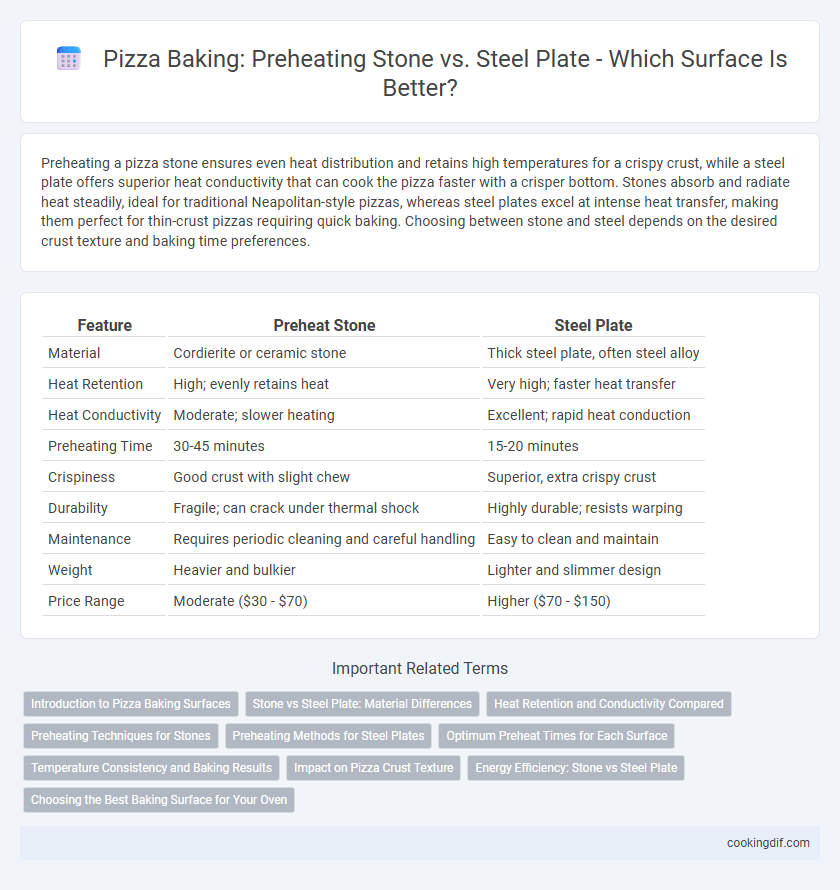Preheating a pizza stone ensures even heat distribution and retains high temperatures for a crispy crust, while a steel plate offers superior heat conductivity that can cook the pizza faster with a crisper bottom. Stones absorb and radiate heat steadily, ideal for traditional Neapolitan-style pizzas, whereas steel plates excel at intense heat transfer, making them perfect for thin-crust pizzas requiring quick baking. Choosing between stone and steel depends on the desired crust texture and baking time preferences.
Table of Comparison
| Feature | Preheat Stone | Steel Plate |
|---|---|---|
| Material | Cordierite or ceramic stone | Thick steel plate, often steel alloy |
| Heat Retention | High; evenly retains heat | Very high; faster heat transfer |
| Heat Conductivity | Moderate; slower heating | Excellent; rapid heat conduction |
| Preheating Time | 30-45 minutes | 15-20 minutes |
| Crispiness | Good crust with slight chew | Superior, extra crispy crust |
| Durability | Fragile; can crack under thermal shock | Highly durable; resists warping |
| Maintenance | Requires periodic cleaning and careful handling | Easy to clean and maintain |
| Weight | Heavier and bulkier | Lighter and slimmer design |
| Price Range | Moderate ($30 - $70) | Higher ($70 - $150) |
Introduction to Pizza Baking Surfaces
Pizza baking surfaces significantly influence crust texture and cooking time, with stone and steel plates as popular choices. Stone absorbs heat slowly, providing even baking and a characteristic crispy crust, while steel plates conduct heat rapidly, resulting in faster cooking and a more pronounced oven spring. Selecting the appropriate surface depends on desired crust qualities and oven type, optimizing the pizza-making experience.
Stone vs Steel Plate: Material Differences
Pizza stones, typically made from ceramic or cordierite, offer excellent heat retention and even heat distribution, creating a crisp crust by absorbing moisture from the dough. Steel plates, forged from thick, food-grade steel, heat up faster and reach higher temperatures, providing superior conductivity and a faster bake time compared to stones. While stones excel in moisture absorption and gentle heat, steel plates deliver intense, consistent radiant heat, ideal for achieving pizzeria-style crust browning.
Heat Retention and Conductivity Compared
A steel plate heats up faster than a stone, offering superior heat conductivity that cooks pizza crust evenly and quickly. Stone excels in heat retention, maintaining stable temperatures for longer baking sessions but requires more time to preheat thoroughly. Choosing between stone and steel depends on prioritizing rapid heat transfer with steel or consistent heat storage with stone for optimal pizza baking performance.
Preheating Techniques for Stones
Preheating a pizza stone requires a longer duration, typically 45-60 minutes at 500degF, to evenly absorb and radiate heat, creating an optimal baking surface that simulates a traditional brick oven. The thermal mass of ceramic stones allows for gradual heat transfer, which avoids hot spots and produces a crispy, well-cooked crust. Proper stone preheating enhances moisture absorption from the dough, resulting in a more flavorful and textured pizza base compared to steel plates that heat up faster but have different heat retention properties.
Preheating Methods for Steel Plates
Steel plates require higher preheating temperatures than stones, typically around 500-550degF, to achieve optimal heat retention and conductivity for a crispy pizza crust. Unlike stones, steel plates heat quickly due to their metal composition, enabling shorter preheat times, often 45-60 minutes in a conventional oven. Proper preheating ensures even cooking and mimics professional pizza ovens by delivering intense bottom heat essential for a perfectly baked pizza.
Optimum Preheat Times for Each Surface
Preheating a pizza stone typically requires 45-60 minutes at 500degF to ensure even heat retention and a crispy crust, while a steel plate reaches optimal temperature faster, around 20-30 minutes, due to its superior thermal conductivity. The steel's high heat transfer rate allows for quicker oven recovery time after opening the door, producing consistent bake results with reduced waiting. Choosing between stone and steel depends on balancing longer preheat times against faster heat responsiveness for perfect pizza baking.
Temperature Consistency and Baking Results
A baking steel maintains higher and more consistent temperatures compared to a pizza stone, ensuring faster cooking times and a perfectly crisp crust. Pizza stones absorb heat and release it more slowly, which can lead to uneven temperature retention and variability in baking results. The superior thermal conductivity of steel promotes an even rise and browning of the pizza base, enhancing overall texture and flavor.
Impact on Pizza Crust Texture
Baking pizza on a preheated steel plate typically results in a crispier, more evenly browned crust due to steel's superior heat conductivity. In contrast, a pizza stone absorbs and retains heat longer, promoting a chewier crust with better overall moisture retention. The choice between stone and steel directly influences the balance between crust crunchiness and tenderness.
Energy Efficiency: Stone vs Steel Plate
Steel plates heat up faster and retain heat better than stone, making them more energy-efficient for baking pizzas. Stone surfaces require longer preheating times due to their higher thermal mass, which increases energy consumption before baking. Using steel plates reduces oven heat loss and shortens cooking times, optimizing overall energy use during pizza preparation.
Choosing the Best Baking Surface for Your Oven
Choosing the best baking surface for your oven greatly impacts pizza quality, with pizza stones and baking steel plates serving unique roles. Pizza stones absorb and distribute heat evenly, creating a crispy crust by drawing moisture from the dough, while steel plates conduct heat faster, offering superior browning and shorter baking times. Home bakers seeking quick, intense heat should consider steel, whereas those preferring gradual, consistent heat retention might opt for a pizza stone.
Preheat stone vs Steel plate for baking surface Infographic

 cookingdif.com
cookingdif.com